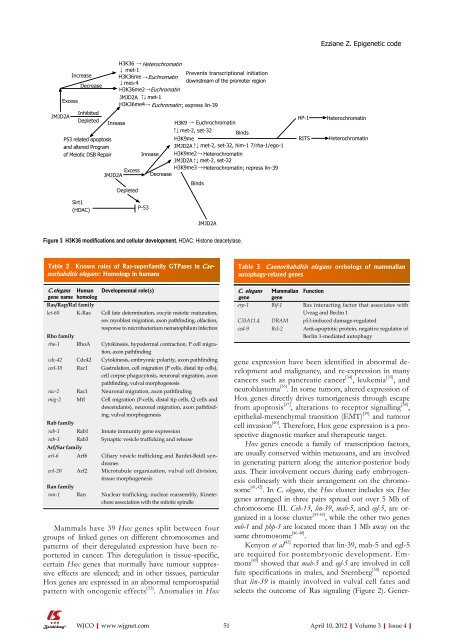World Journal of Clinical Oncology
World Journal of Clinical Oncology
World Journal of Clinical Oncology
Create successful ePaper yourself
Turn your PDF publications into a flip-book with our unique Google optimized e-Paper software.
JMJD2A<br />
Excess<br />
Increase<br />
Decrease<br />
Inhibited<br />
Depleted<br />
Sirt1<br />
(HDAC)<br />
Inrease<br />
Depleted<br />
P-53<br />
Mammals have 39 Hox genes split between four<br />
groups <strong>of</strong> linked genes on different chromosomes and<br />
patterns <strong>of</strong> their deregulated expression have been reportered<br />
in cancer. This deregulation is tissue-specific,<br />
certain Hox genes that normally have tumour suppressive<br />
effects are silenced; and in other tissues, particular<br />
Hox genes are expressed in an abnormal temporospatial<br />
pattern with oncogenic effects [33] . Anomalies in Hox<br />
WJCO|www.wjgnet.com<br />
H3K36 → Heterochromatin<br />
↓ met-1<br />
Prevents transcriptional initiation<br />
H3K36me →Euchromatin<br />
↓ mes-4<br />
downstream <strong>of</strong> the promoter region<br />
H3K36me2→Euchromatin<br />
JMJD2A ↑↓ met-1<br />
H3K36me4→<br />
Euchromatin ; express lin-39<br />
H3K9 → Euchrochromatin<br />
↑↓ met-2, set-32<br />
P53 related apoptosis<br />
and altered Program<br />
<strong>of</strong> Meiotic DSB Repair<br />
JMJD2A Excess<br />
Binds<br />
H3K9me<br />
JMJD2A ↑↓ met-2, set-32, him-1 7/rha-1/ego-1<br />
Inrease H3K9me2→ Heterochromatin<br />
JMJD2A ↑↓ met-2, set-32<br />
H3K9me3 →Heterochromatin; repress lin-39<br />
Decrease<br />
Binds<br />
JMJD2A<br />
Figure 3 H3K36 modifications and cellular development. HDAC: Histone deacetylase.<br />
Table 2 Known roles <strong>of</strong> Ras-superfamily GTPases in Caenorhabditis<br />
elegans : Homologs in humans<br />
C.elegans<br />
gene name<br />
Human<br />
homolog<br />
Ras/Rap/Ral family<br />
Developmental role(s)<br />
let-60 K-Ras Cell fate determination, oocyte meiotic maturation,<br />
sex myoblast migration, axon pathfinding, olfaction,<br />
response to microbacterium nematophilum infection<br />
Rho family<br />
rho-1 RhoA Cytokinesis, hypodermal contraction, P cell migration,<br />
axon pathfinding<br />
cdc-42 Cdc42 Cytokinesis, embryonic polarity, axon pathfinding<br />
ced-10<br />
Rac1 Gastrulation, cell migration (P cells, distal tip cells),<br />
cell corpse phagocytosis, neuronal migration, axon<br />
pathfinding, vulval morphogenesis<br />
rac-2 Rac1 Neuronal migration, axon pathfinding<br />
mig-2 Mtl Cell migration (P-cells, distal tip cells, Q cells and<br />
descendants), neuronal migration, axon pathfinding,<br />
vulval morphogenesis<br />
Rab family<br />
rab-1 Rab1 Innate immunity gene expression<br />
rab-3 Rab3 Synaptic vesicle trafficking and release<br />
Arf/Sar family<br />
arl-6 Arf6 Ciliary vesicle trafficking and Bardet-Beidl syndromes<br />
evl-20 Arf2 Microtubule organization, vulval cell division,<br />
tissue morphogenesis<br />
Ran family<br />
ran-1 Ran Nuclear trafficking, nuclear reassembly, Kinetechore<br />
association with the mitotic spindle<br />
HP-1 Heterochromatin<br />
RITS Heterochromatin<br />
Table 1 3 Levels Caenorhabditis <strong>of</strong> sIL-2R, ALT, elegans and orthologs HBV DNA <strong>of</strong> in mammalian the sera <strong>of</strong><br />
patients autophagy-related with chronic genes HBV infection (mean ± SD)<br />
C. elegans<br />
gene<br />
Mammalian<br />
gene<br />
Function<br />
Ezziane Z. Epigenetic code<br />
erp-1 Bif-1 Bax interacting factor that associates with<br />
Uvrag and Beclin 1<br />
C33A11.4 DRAM p53-induced damage-regulated<br />
ced-9 Bcl-2 Anti-apoptotic protein, negative regulator <strong>of</strong><br />
Beclin 1-mediated autophagy<br />
gene expression have been identified in abnormal development<br />
and malignancy, and re-expression in many<br />
cancers such as pancreatic cancer [34] , leukemia [35] , and<br />
neuroblastoma [36] . In some tumors, altered expression <strong>of</strong><br />
Hox genes directly drives tumorigenesis through escape<br />
from apoptosis [37] , alterations to receptor signalling [38] ,<br />
epithelial-mesenchymal transition (EMT) [39] and tumour<br />
cell invasion [40] . Therefore, Hox gene expression is a prospective<br />
diagnostic marker and therapeutic target.<br />
Hox genes encode a family <strong>of</strong> transcription factors,<br />
are usually conserved within metazoans, and are involved<br />
in generating pattern along the anterior-posterior body<br />
axis. Their involvement occurs during early embryogenesis<br />
collinearly with their arrangement on the chromosome<br />
[41,42] . In C. elegans, the Hox cluster includes six Hox<br />
genes arranged in three pairs spread out over 5 Mb <strong>of</strong><br />
chromosome III. Ceh-13, lin-39, mab-5, and egl-5, are organized<br />
in a loose cluster [43-45] , while the other two genes<br />
nob-1 and php-3 are located more than 1 Mb away on the<br />
same chromosome [46-48] .<br />
Kenyon et al [42] reported that lin-39, mab-5 and egl-5<br />
are required for postembryonic development. Emmons<br />
[49] showed that mab-5 and egl-5 are involved in cell<br />
fate specifications in males, and Sternberg [50] reported<br />
that lin-39 is mainly involved in vulval cell fates and<br />
selects the outcome <strong>of</strong> Ras signaling (Figure 2). Gener-<br />
51 April 10, 2012|Volume 3|Issue 4|

















